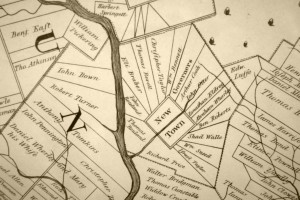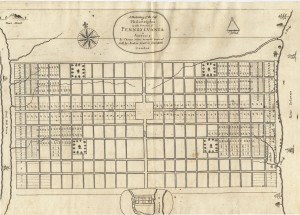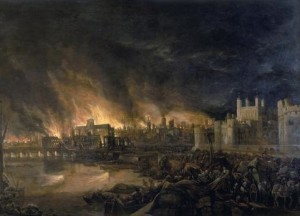New arrivals in Pennsylvania could not just ride out into the countryside and claim a tract for their own. Penn set up an orderly process for laying out land purchases. Many of the emigrants had bought rights to land from him in England as First Purchasers. Others had bought up the rights from a First Purchaser. 1 Once they got off the boat, they went to Penn in Philadelphia and requested a survey, asking for all or part of their purchase to be laid out. Penn sent a warrant to Thomas Holme, asking him to have the land surveyed. Here is a typical warrant from Penn to Holme:
William Penn proprietary and Governor of the province of Pennsylvania and the territories thereunto belonging. At the request of Nicholas Rendal late purchaser one hundred and fifty acres that I would grant him to take up the said land in the county of Philadelphia. These are to will and require thee forthwith to survey or cause to be surveyed onto him the said number of acres in the aforementioned County where not already taken up according to the method of townships appointed by me, he seating the same according to regulation and make returns thereof into my secretary’s office. Given at Philadelphia the 12th of the fourth month 1684.
For Thomas Holme Surveyor General.
[Holme added a note at the bottom.] 18th ordered T.F. [Thomas Fairman] to lay it out in Warminster Township if room there, to join to his father’s acres. 2
Holme might do the survey himself, or more often would delegate one of his assistants: typically Charles Ashcom for Chester County, Thomas Fairman for Philadelphia County, Israel Taylor for Bucks County. These men would direct the survey, which required a team of men — the surveyor and his chainmen. 3 The chainmen carried heavy chains, of known length, which they laid out according to directions from the surveyor. He used a compass, and possibly other tools such as a theodolite (for measuring angles), a protractor (for drawing angles), and a quadrant (for measuring altitude). 4 The survey was supposed to include an extra 6 percent allowance for roads that might be run through it at some time, although a shady surveyor might add extra land to please the purchaser and increase his fee. The fee was supposed to be shared, with one-third to the surveyor and two-thirds for Holme. 5 In practice the deputy surveyors tried to avoid sending Holme his fees, leading to several lawsuits. 6
Once the land was surveyed the purchaser could live on it, rent it out or sell it. If he did not settle on it in a reasonable amount of time, it could be forfeit to Penn, as in the warrant above, “….seating the same according to regulation.” In practice this was rare.
The final step in the purchase process was the patent. The owner could apply to the land office for a patent giving him full title to the land. After paying a fee he would receive a paper describing the property and documenting his right to it. Because there was a fee for this, owners often didn’t get a patent, and sold the land without one. But a cautious buyer would insist on it, and often a patent was dated just before the sale of the land.
- They could also buy land from Penn once they arrived. ↩
- Warrant #2071. Warrant and Survey Book 1, Philadelphia City Archives ↩
- In later years the team also included axmen, who cleared trees and brush along the boundaries of the tract. In the early years when Holme had fewer helpers, the chainmen probably doubled as axmen. ↩
- Corcoran, Thomas Holme, p. 35 ↩
- Munger, Guide to Pennsylvania Land Records. ↩
- Holme sued Taylor in 10th month 1686 (Court records of Bucks County) and Ashcom in 7th month 1690 (Court records of Chester County). ↩



